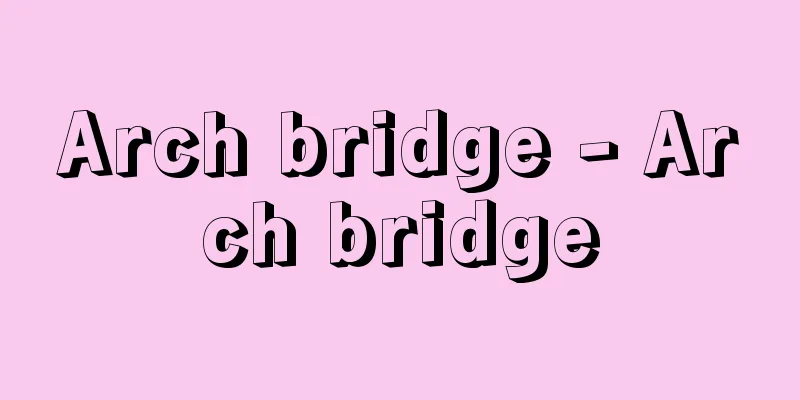Arch bridge - Arch bridge

|
A classification of bridges based on their structural type, with the main part being an arch bridge. Arches are primarily designed to resist compressive forces, but recently many have been designed to resist bending and shear forces as well. Steel and concrete are used as materials. In the past, stone was used, such as in Roman aqueducts. Arches are divided into rib arches and spandrel braced arches depending on whether they have ribs (independent arch rings that are parallel to the bridge axis and usually lie in a vertical plane). Those with solid ribs are called solid rib arches, and those with truss-type ribs are called braced rib arches. There are also pipe arches that use pipes for the ribs, and voussoir arches that are supported by stone or other materials. Arches are divided into three-hinge and two-hinge arches depending on the number of hinges. Arches without hinges are called fixed arches. Arches with both supports connected by ties are called tied arches. Those that use stiffening girders as ties to resist bending are called Lohse bridges, and those with stiffening girders that are so rigid that the arch cannot resist bending are called Langer bridges. These are collectively called stiffened arch bridges. Arch bridges have a long history, with many surviving stone arch bridges from the Roman era. Japan has many arch bridges, including Nagasaki's Meganebashi Bridge (built in 1634, partially damaged in heavy rains in 1982) and Iwakuni's Kintaikyo Bridge (built in 1673). The world's largest steel arch bridge is the New River Gorge Bridge in West Virginia, USA (built in 1977, span 518 meters), and Japan's largest steel arch bridge is the Omishima Bridge in Ehime Prefecture (built in 1979, span 297 meters). [Shoichi Kobayashi] © Shigeru Yoshizaki Main types of arch bridges Nationally designated important cultural property Nagasaki City, Nagasaki Prefecture © Nagasaki Tourism Federation Spectacles Bridge (Nagasaki City) Nationally designated scenic spot Iwakuni City, Yamaguchi Prefecture ©Yamaguchi Prefecture Tourism Federation Kintai Bridge Source: Shogakukan Encyclopedia Nipponica About Encyclopedia Nipponica Information | Legend |
|
構造形式による橋の分類の一つで、主要部分がアーチ状の橋。アーチはおもに圧縮力に抵抗するが、最近では曲げや剪断(せんだん)にも抵抗できるように設計したものも多い。材料には鋼、コンクリートが用いられる。古くはローマの水道橋などのように石材を用いた。 アーチはリブrib(橋軸に平行で通常鉛直面内にある独立したアーチリング)の有無によりリブアーチとスパンドレル・ブレースドアーチspandrel braced archに分けられる。リブが充実構造のものをソリッドリブ・アーチsolid rib archといい、トラス形式のものをブレースドリブアーチbraced rib archという。なお、リブにパイプを用いたパイプアーチpipe archや、石材などでせり持ちにしたブーソアアーチvoussoir archもある。アーチはヒンジhinge(蝶番(ちょうつがい))の数により、3ヒンジおよび2ヒンジアーチに分けられる。ヒンジをもたないものを固定アーチという。また、アーチの両支点間をつなぎ材で連結したものをタイドアーチtied archという。なお、つなぎ材として曲げに抵抗するように補剛桁(ほごうげた)を用いたものをローゼLohse橋、補剛桁の剛性を大きくしアーチは曲げに抵抗しえない構造としたものをランガーLanger橋という。これらをまとめて補剛アーチ橋という。アーチ橋の歴史は古く、ローマ時代の石造アーチ橋で現存するものも多い。日本にも長崎の眼鏡橋(めがねばし)(1634年架設、1982年の豪雨で一部破損)、岩国の錦帯橋(きんたいきょう)(1673年架設)など数多くのアーチ橋がある。世界最大の鋼アーチ橋はアメリカ、ウェスト・バージニア州のニューリバーゴージ橋(1977年架設。支間518メートル)、日本最大の鋼アーチ橋は愛媛県の大三島橋(おおみしまばし)(1979年架設。支間297メートル)である。 [小林昭一] ©吉崎 茂"> アーチ橋のおもな形式 国指定重要文化財 長崎県長崎市©一般社団法人長崎県観光連盟"> 眼鏡橋〈長崎市〉 国指定名勝 山口県岩国市©一般社団法人山口県観光連盟"> 錦帯橋 出典 小学館 日本大百科全書(ニッポニカ)日本大百科全書(ニッポニカ)について 情報 | 凡例 |
Recommend
Kyusen - Kyusen (English spelling) Multicolorfin wrasse
A marine fish belonging to the order Perciformes,...
transzendental
...Therefore, transcendence here is nothing other...
Sanjaya
...This is the name of a place in the vicinity of...
Air Mass Transformation Experiment
…The second objective is to thoroughly investigat...
Jean-François Paillard
1928‐ French conductor. After studying mathematics...
Bernard Forest de Bélidor
1693‐1761 French soldier and civil engineer. A for...
Drin Drugs - Drinzai
A type of organochlorine insecticide, a general t...
Kishiha
A school of painting from the late Edo period thr...
Snapper (Fuedai) - Lutjanus stellatus
A marine fish of the Lutjanidae family in the orde...
reckless
…Such cases can occur in all crimes, but the ones...
Spanish Empire
Generally, it refers to Spain from the 16th centur...
《Problem of Chance》 - Problem of Chance
…He had already published many papers while in Eu...
Kamitsushima [town] - Kamitsushima
An old town in the northeastern part of Tsushima, ...
Administrative management - Gyoseikanri (English spelling) administrative management
This refers to the secondary business of maintaini...
splint
...A type of splint used primarily to immobilize ...









